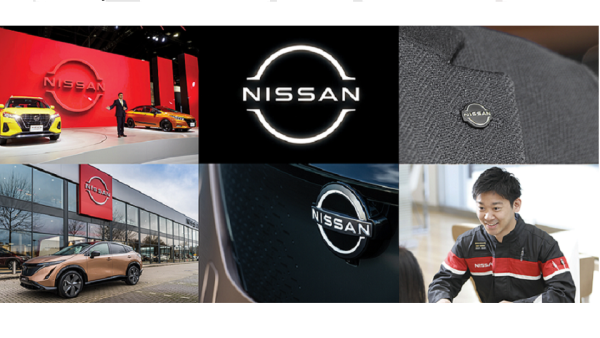Giving Shape To Brand Identity

When you think of a designer working for a car company, the first thing that comes to mind may be a person making sketches of vehicle bodies. In reality, automotive designers work on a multitude of things – from car emblems to logos, motor show booths, dealerships, company uniforms and more. The scale and materials vary widely, but everything fits together as part of a unified brand identity.
“We design things with all sorts of different materials and sizes, but the basic idea – trying to give shape to the brand’s spirit and identity – is the same,” says Nissan designer Hiroyuki Sakurai.
【Hiroyuki Sakurai, space/brand experience designer】 【Naoki Yamamoto, car emblem designer】
Designing spaces
At Nissan, dedicated designers work on buildings and spaces such as company buildings, motor show booths and dealerships.
【Nissan’s space designers work on company buildings and spaces – Interior of NISSAN CROSSING】
“We often apply elements from cars to space design,” Sakurai says. “The Nissan Pavilion event space, where we unveiled the new Nissan Ariya electric crossover last year, incorporated elements of the Ariya’s design – a contrast between tradition and innovation.”
【Nissan Pavilion】
Showcasing cars in the digital age
Designers are also increasingly inspired by the intersection of physical and virtual experiences.
“We’re trying to blaze a new path by offering novel experiences, such as driving a heritage car, or a futuristic car that hasn’t been made yet,” Sakurai says. “Virtual reality devices are increasingly used for both car design and space design. For instance, we can use a VR headset to change the time, the season and the lighting. This is because the external ambiance is part of how we experience a car.”
【Virtual meets physical at the Nissan Pavilion】
Car emblems
As the “face” of a car, badges and emblems are key to a carmaker’s identity. In addition to the company badge – in Nissan’s case, spelling out the company name – there are also emblems naming the model and signifying the specification or grade. Each is created by dedicated designers to fit the specific model.
Changing with the times
Until around the 2000s, fonts and decorations of Nissan’s car emblems varied from model to model, depending on the character of each car. Emblem designer Naoki Yamamoto was captivated by the elegant emblems of high-end cars when he first joined Nissan.
【Car emblems have evolved over time】
“The 1990s was a time when customers preferred colorful, decorative emblems,” he says. “For instance, the Cedric and Gloria at the time had beautiful, cursive-lettered emblems with a golden fringe.”
【Cedric car emblem with golden fringe in the 1990’s】
In 2001, Nissan decided to unify the brand’s global identity. Fonts, colors, the surface finish and position of emblems were made almost the same. Within the unified rules, designers could still decide on details such as size and the precise position for each model.
Z and GT-R
The Nissan Z and GT-R, however, continued to have special emblems. Last September, the company unveiled the Z Proto, a prototype of the next-generation Z car. The Z Proto’s diagonal, cursive-lettered emblem is a homage to the first-generation Z. The circled “Z” emblem on the side has also been handed down for generations. Meanwhile, the GT-R uses an emblem with the letters “GT-R” and vivid red color. This font is also unique to the GT-R.
【The Nissan Z and GT-R have unique emblem designs】
New car badge and font
Along with introducing Nissan’s new brand logo, the Ariya also ushered in a new standard font for emblems, with a new color, luster and cross‐sectional shape. The “Nissan” badge in front also features an illuminated design, specifically designed to give our electric vehicles a more futuristic appearance.
The brand’s new identity is being brought to life by designers like Sakurai and Yamamoto, as they reimagine the spaces and new emblems that represents the new chapter for Nissan.
Background Information
Nissan Middle East
Nissan’s heritage in the Middle East goes way back to 1957, when the first Nissan vehicle was sold in Saudi Arabia. Since then the Nissan Legacy has taken deep roots in the hearts of the Middle East people by becoming an integral part of their lives.
Currently Nissan is one of the most popular and successful automobile brands in the Middle East boasting of a strong line-up ranging from popular passenger cars to powerful 4x4 series and commercial vehicles.
In its quest to closely understand the local needs of its customers, Nissan Motor Co. Ltd. in June, 1994 set up a regional Middle East head quarters in Dubai, thus becoming the first Japanese car manufacturer to accomplish this feat. The Nissan Middle East FZE office houses a highly sophisticated training center which serves as an excellent training ground for undertaking Nissan customer care and service activities.






